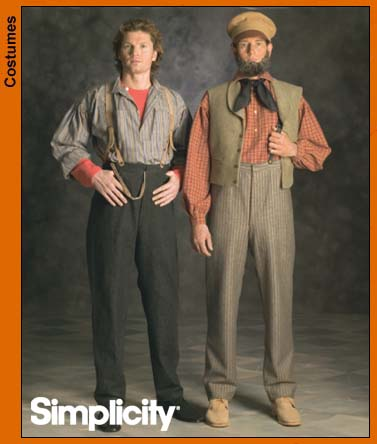|
Pioneer
Clothing
WHAT TO WEAR
ON THE TREK:

Dressing in pioneer clothing can
have a tremendous impact on the spirit of the trek.
The following is a short description of how pioneers
dressed and it is our hope that the youth will dress
likewise for the trek.
Each Ward will have a Clothing
Specialist called who will help all their youth get
their clothing together. The Ward Clothing
Specialist will work with the Stake Clothing
Specialist to make sure everyone has the clothes they
need for the trek.
Menís clothing:
Menís shirts worn loose.
Plain colors were common, but stripes or plaids were
also used. Light colors will be coolest. Choose
something larger than a regular fit, with long
sleeves.
Pants were also worn
loose. Wool or linen were used. Corduroy, twill and
canvas pants are good choices. Trekker in our day
find that wool is to hot but that cotton work great.
Colors include blue, black, gray, browns, especially
beige and tan. Choose rather loose fitting through
the crotch and thigh area to add comfort In walking.
Suspenders; Menís pants
were held up by suspenders that were buttoned on the
outside of the waistband, and crossed in the back.
Hats: Menís everyday hats
ranged from pilot caps, straw hats, wide brimmed low
felt hats, or round crowned hat. No ball caps
allowed.
Ties; Usually vests/ties
were worn only on Sunday or when attending a meeting
or social event. Ties were small, black and silky.
Wrapped around the neck one and tied in the front with
a square knot.
Womenís clothing:
**Pricing:
The Stake Clothing Specialist purchased enough
material to make an apron, bonnet, and skirt.
The total cost in the end was only $7.00 to make them
all. (That did not include thread.)
Dresses: Womenís basic
dresses were floor length. It could be plain or have
many ruffles. The sleeves were full, and long, with
buttons or bands at the writs. Necklines were usually
high, with buttons up the front. Fabrics were cotton
in solid colors or small print. Bright colors were
popular (especially bright yellow) Blouses and long
skirts or jumpers could be used. Pioneer trekkers now
have found that dresses and skirts should be mid-calf
or above top of a hiking boot in length (so the girls
do not trip over their skirts while pulling).
Aprons; The standard apron
was six to twelve inches shorter than the skirt
length. It gathered at the waist and tied. The bib
attached at the waist and was pinned to the dress
bodice at the top two corners. Hence, the name
pinafore (Pinned at two of the for corners). Daytime
aprons were made of calico remnants. Sunday aprons
were made from white fabric and did not have a bib.
For trekking today, large deep pockets are important
to be able to carry different items along the trial.
Here's a pattern you can use:
http://handcart-trek.org/patterns/Aprons.pdf
Bonnets; Women wore
bonnets whenever they were outside. They were made of
cotton with a deep stiffened brim and back ruffle to
protect the neck. They could be white, plain colors
or a print, but they never matched the fabric of the
dress. Today, bonnets or straw hats for the girls are
important, they need to have something they will wear
to protect them from the sun.
Bonnet Patterns (PDF-243KB)
Here's another Pioneer Bonnet Pattern:
click here to enlarge

Pantaloons were worn
underneath the dress and were normally white. Reached
between knee and mid calf. Could use scrubs or pajama
pants hemmed shorter. Wearing pantaloons helps
maintain modesty in trekking situations. (Although
the young women often wear denim jeans, on the trek
they should be discouraged because they are too tight,
hot and donít breathe.) Here's a pattern:
http://handcart-trek.org/patterns/Petticoats.pdf
Shoes; For both women and
men, shoes need not be ďperiodĒ style. Comfort is
most important. Do not wear new hiking boots unless
you have taken at least two months to break them in.
Bring two pair, so if one gets wet or cause blisters,
the other pair can be worn.
Socks; Pack clean socks
for each day.
Clothing Sources: 2nd
hand stores or borrowed clothing. A Trek Clothing
Specialist will be available to work with each ward to
ensure proper clothing is assembled for each youth on
the trek. Sewing workshops will be arranged to
accomplish the clothing preparation task. Authentic
patterns can be obtained from
www.patterns.com/1830.html also look under
1840-1850ís . The Stake Youth Conference Specialists
will provide a basic pattern for the womenís clothing.
What
NOT TO Wear
Blue jeans, baseball caps, tank tops, t shirts,
tight/short dresses, brand new shoes.
Clothing Patterns
Simplicity:
www.simplicity.com
Womenís Simplicity Patterns Ė
5041 &
5375
Menís Simplicity Patterns Ė
5023 &
5035
Butterick:
www.butterick.com
Womenís Butterick Patterns Ė
4570 &
3992
Menís Butterick Pattern Ė
3896
McCallís:
www.mccallpattern.com
Womenís McCall Patterns Ė
3669 &
4548
The Historical Pattern Company:
www.pastpatterns.com/1830.html
Various menís and womenís patterns are shown on this
website.
If you want to buy custom made
high quality authentic pioneer clothes, visit:
http://www.calicoannie.net/oldwestandpioneerclothing.htm
Very extensive selection. The
older ladies behind that site (there are 4 little
elderly
ladies who sew the clothes) are very nice, very good
at what they do, efficient, and skilled, but
brace yourself for steep pricing, because they use
only period materials and materials like that don't
come cheap!
Mormon Handicraft
also has some pioneer clothes you can buy (a
little cheaper than calicoannie.net) http://deseretbook.com/mormonhandicraft/browse?cat=243
Questions Ė call
Greg or Susie Phillips 652-1444
Doreen Finley 673-8675
|
|

Menís Butterick Pattern
3896
|
This site
is not an official Church website and should be used
only as a resource for Trek preparation and
information.
Copyright ©
Handcart-Trek.org |
All Rights Reserved |